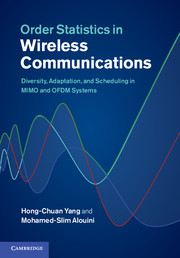 Order Statistics in Wireless Communications
Order Statistics in Wireless Communications 3 - Distributions of order statistics
Published online by Cambridge University Press: 07 October 2011
Summary
Introduction
The previous chapter shows that the performance analysis of wireless communication systems requires the statistics of the signal-to-noise ratio (SNR) at the receiver. In the analysis of many advanced wireless communication techniques in later chapters, we will make use of some order statistical results. This chapter summarizes these results and their derivations for easy reference. Specifically, we first review the basic distribution functions of ordered random variables. After that, we derive some new order statistics results, including the joint distribution functions of partial sums of ordered random variables, for which we also present a novel analytical framework based on the moment generating function (MGF). The chapter is concluded with a discussion on the limiting distributions of extremes. Whenever appropriate, we use the exponential random variable special case as an illustrative example. Note that we focus on those order statistics results that will be employed in later chapters in the performance and complexity analysis of different wireless technologies. For a more thorough treatment of order statistics, the readers are referred to [1, 2].
Basic distribution functions
Order statistics deals with the distributions and statistical properties of the new random variables obtained after ordering the realizations of some random variables. Let γj's, j = 1, 2,…, L denote L independent and identically distributed (i.i.d.) nonnegative random variables with common PDF pγ (·) and CDF Fγ(·). Let γl:L denote the random variable corresponding to the lth largest observation of the L original random variables, such that γ1:L ≥ γ2:L ≥ … ≥ γL:L · γl:L is also called lth order statistics. The ordering process is illustrated in Fig. 3.1.
- Type
- Chapter
- Information
- Order Statistics in Wireless CommunicationsDiversity, Adaptation, and Scheduling in MIMO and OFDM Systems, pp. 40 - 71Publisher: Cambridge University PressPrint publication year: 2011
- 4
- Cited by


